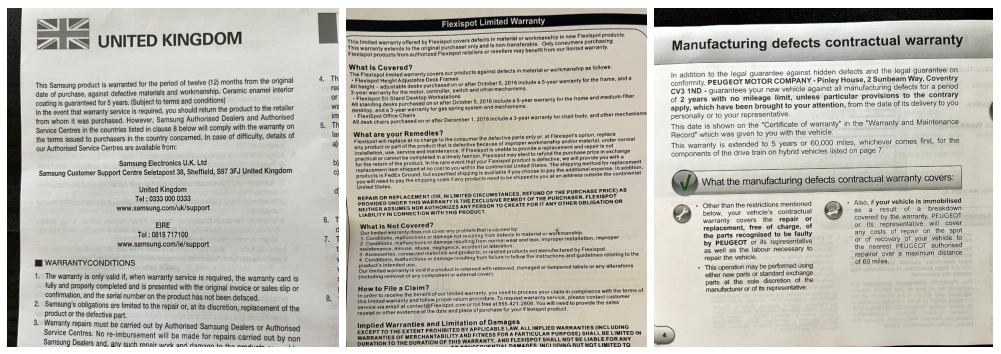Product warranties are an important consideration for most manufacturers of consumer products (industrial and B2B products may be dealt with contractually and so are often a bit different).
This discussion covers:
- How product reliability, durability, and warranties are connected.
- What a product warranty is.
- How warranties build consumer trust and brand loyalty.
- Real warranty examples from products we’ve purchased, including what is covered and why or why not.
- The varying legal requirements for warranties across different regions, including the USA, Canada, the EU, and the UK.
- Short versus long warranties and their impact on consumer trust.
- Why designing products for reliability and conducting thorough testing is critical for minimizing early failures and costly warranty claims.
- Several actionable tips for manufacturers on standardizing warranty policies, offering extended warranties, and continuously monitoring product returns to improve overall quality and customer satisfaction.
Here’s a summary of some of the main points, listen for the full episode…
What is a product warranty?
The warranty signals that customers can trust the product. It’s often a guarantee to refund, repair, or replace a faulty product within a set time after purchase. (02:28)
Real Warranty Examples and Case Studies.
Examining a few real warranty examples for consumer products:
- Samsung microwave oven: Warranty of 12 months from purchase date which covers defective materials and workmanship. This does not cover against the consumer disliking the product design or performance.
- Office chair: Limited warranty covering defective materials and workmanship, 5 years for frame, 3 years for motor/controller/switches/mechanisms.
- Peugeot automobile: 5-year manufacturing defects contractual warranty, damage caused by natural phenomena and use of non-original parts excluded, as are the tyres. The warranty is also void if regular maintenance is not carried out. Paintwork, anti-perforation, and hybrid components have coverage of different lengths. For complex products like cars, warranties may be split into several different sections. (04:23)
Warranties for marketing and how to use them?
From a marketing and product image point of view, a warranty helps the customer know that the product is reliable and gives them peace of mind that if there is an issue they will not have to pay anything to fix it for a period which helps them to decide to buy it.
German home electronics brand Miele provides a very long 20-year warranty showing that they’re extremely confident in their products’ quality. Although many people may have lost the proof of purchase by then.
Some manufacturers will require evidence when there is a warranty claim. For example, an auto brand may request the car to be driven to an authorized garage for inspection, or a consumer electronic brand may request photos and videos to be sent demonstrating the issue. (15:53)
Warranty Legal Requirements for Consumer Products and Comparing Warranty Laws Across Regions.
Some countries will legally require consumer products to have a warranty of a certain length that covers repair, refund, or replacement.
- USA: The FTC say that not all products need a warranty and there is no mandatory minimum coverage period. But for qualifying products, the warranty terms must be clearly explained, typically a one-year warranty is normal, and limited or full warranties for certain products, comply with federal and state laws regarding product returns and replacement.
- Canada: No specific warranty length, but must be a reasonable time based on the product type.
- EU: Tougher standards. 2-year minimum warranty for consumer products covering repair, refund, or replacement. Must be complied with to sell on the market. Extended warranties can be sold in addition.
- UK: Similar protections as the EU, and a 30-day no-quibble guarantee where the consumer can return the product for any reason for a refund. (22:11)
Warranty Impact on Consumer Trust.
Short warranties for consumer products may reduce trust, as people are used to 1-year warranties. Non-consumer products may have shorter warranties as they are not covered by the earlier legislation, and will be covered on a contractual basis. (30:15)
Now, please listen to the recording for the rest of the episode!
32:27 – Designing Products with the Warranty in Mind.
42:12 – Best Practices for Warranty Management.
47:23 – Closing Thoughts.
Related content…
- Warranty definition
- USA Magnuson Moss Warranty-Federal Trade Commission Improvements Act
- Canada Sale of Goods Act
- EU Consumer Rights Directive
- Consumer Rights Act (UK)
- Ongoing Reliability Testing: Avoid Returns, Bad Reviews, and Warranty Claims!
- What is the product return rate and how to reduce it? [Podcast]
Disclaimer
We are not lawyers. What we wrote above is based only on our understanding of legal requirements. QualityInspection.org does not present this information as a basis for you to make decisions, and we do not accept any liability if you do so.

